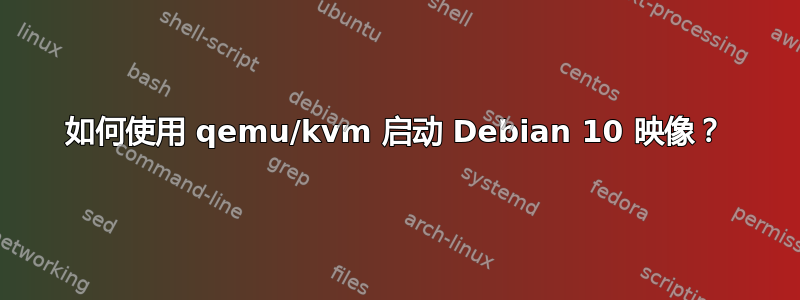
我正在尝试使用 qemu 启动 Debian 10 的 openstack 映像并遇到检测硬盘的错误,启动序列结束时显示:
[ 0.989085] Run /init as init process
Loading, please wait...
Starting version 241
[ 1.068365] SCSI subsystem initialized
[ 1.073933] cryptd: max_cpu_qlen set to 1000
[ 1.085586] AVX2 version of gcm_enc/dec engaged.
[ 1.085699] PCI Interrupt Link [LNKA] enabled at IRQ 10
[ 1.086342] AES CTR mode by8 optimization enabled
[ 1.094169] scsi host0: ata_piix
[ 1.095524] scsi host1: ata_piix
[ 1.096120] ata1: PATA max MWDMA2 cmd 0x1f0 ctl 0x3f6 bmdma 0xc2c0 irq 14
[ 1.097198] ata2: PATA max MWDMA2 cmd 0x170 ctl 0x376 bmdma 0xc2c8 irq 15
[ 1.108170] PCI Interrupt Link [LNKB] enabled at IRQ 11
[ 1.120402] virtio_blk virtio0: [vda] 736 512-byte logical blocks (377 kB/368 KiB)
Begin: Loading essential drivers ... done.
Begin: Running /scripts/init-premount ... done.
Begin: Mounting root file system ... Begin: Running /scripts/local-top ... done.
Begin: Running /scripts/local-premount ... done.
Begin: Waiting for root file system ... Begin: Running /scripts/local-block ... done.
Begin: Running /scripts/local-block ... done.
Begin: Running /scripts/local-block ... done.
... line repeats ...
Begin: Running /scripts/local-block ... done.
Begin: Running /scripts/local-block ... done.
done.
Gave up waiting for root file system device. Common problems:
- Boot args (cat /proc/cmdline)
- Check rootdelay= (did the system wait long enough?)
- Missing modules (cat /proc/modules; ls /dev)
ALERT! UUID=77e3f255-2ef2-47bc-ad89-7cdbd65f5fbc does not exist. Dropping to a shell!
BusyBox v1.30.1 (Debian 1:1.30.1-4) built-in shell (ash)
Enter 'help' for a list of built-in commands.
从 initramfs 提示符中,我可以看到以下内容:
(initramfs) cat /proc/cmdline
BOOT_IMAGE=/boot/vmlinuz-4.19.0-5-cloud-amd64 root=UUID=77e3f255-2ef2-47bc-ad89-7cdbd65f5fbc ro biosdevname=0 net.ifnames=0 console=tty0 console=ttyS0,115200 earlyprintk=ttyS0,115200 consoleblank=0 systemd.show_status=true
(initramfs) cat /proc/modules
ata_generic 16384 0 - Live 0xffffffffc00ba000
crc32c_intel 24576 0 - Live 0xffffffffc00b3000
virtio_blk 20480 0 - Live 0xffffffffc00ad000
aesni_intel 200704 0 - Live 0xffffffffc0156000
ata_piix 36864 0 - Live 0xffffffffc0147000
aes_x86_64 20480 1 aesni_intel, Live 0xffffffffc0135000
crypto_simd 16384 1 aesni_intel, Live 0xffffffffc0130000
libata 245760 2 ata_generic,ata_piix, Live 0xffffffffc00da000
cryptd 28672 2 aesni_intel,crypto_simd, Live 0xffffffffc00d2000
glue_helper 16384 1 aesni_intel, Live 0xffffffffc00cb000
scsi_mod 237568 1 libata, Live 0xffffffffc0072000
virtio_pci 28672 0 - Live 0xffffffffc0066000
virtio_ring 28672 2 virtio_blk,virtio_pci, Live 0xffffffffc005b000
virtio 16384 2 virtio_blk,virtio_pci, Live 0xffffffffc0053000
(initramfs) ls /dev
block tty18 tty5
char tty19 tty50
console tty2 tty51
core tty20 tty52
cpu_dma_latency tty21 tty53
disk tty22 tty54
fd tty23 tty55
full tty24 tty56
hpet tty25 tty57
input tty26 tty58
kmsg tty27 tty59
mem tty28 tty6
memory_bandwidth tty29 tty60
network_latency tty3 tty61
network_throughput tty30 tty62
null tty31 tty63
psaux tty32 tty7
ptmx tty33 tty8
pts tty34 tty9
random tty35 ttyS0
snapshot tty36 ttyS1
stderr tty37 ttyS2
stdin tty38 ttyS3
stdout tty39 urandom
tty tty4 vcs
tty0 tty40 vcs1
tty1 tty41 vcsa
tty10 tty42 vcsa1
tty11 tty43 vcsu
tty12 tty44 vcsu1
tty13 tty45 vda
tty14 tty46 vga_arbiter
tty15 tty47 zero
tty16 tty48
tty17 tty49
(initramfs) ls /dev/disk/by-label/
cidata
(initramfs) ls -al /dev/disk/by-uuid/
total 0
drwxr-xr-x 2 0 0 60 Jul 22 00:07 .
drwxr-xr-x 5 0 0 100 Jul 22 00:07 ..
lrwxrwxrwx 1 0 0 9 Jul 22 00:07 2019-07-21-20-02-09-00 -> ../../vda
要重新创建此虚拟机,首先我从下载的基础映像(从openstack 图像站点):
~/vm/deb10-test$ sha256sum ../base-debian-10/base.qcow2
d4c2966d996a3e08c198be41640d54b5d0c038cfc21b4d05e4b769824974daaf ../base-debian-10/base.qcow2
~/vm/deb10-test$ qemu-img create -f qcow2 -o "backing_file=../base-debian-10/base.qcow2" image.qcow2 20G
Formatting 'image.qcow2', fmt=qcow2 size=21474836480 backing_file=../base-debian-10/base.qcow2 encryption=off cluster_size=65536 lazy_refcounts=off refcount_bits=16
接下来我seed.img使用以下命令设置 cloud-init cloud-localds:
~/vm/deb10-test$ cat meta-data
instance-id: iid-deb10-test-20190721-193118
hostname: deb10-test
local-hostname: deb10-test
~/vm/deb10-test$ cat network-config
---
version: 1
config:
- type: physical
name: eth0
subnets:
- type: static
address: 192.168.237.42
netmask: 255.255.255.0
routes:
- network: 0.0.0.0
netmask: 0.0.0.0
gateway: 192.168.237.1
- type: nameserver
address: [192.168.234.10, 192.168.234.254, 8.8.8.8]
search: []
~/vm/deb10-test$ cat user-data
#cloud-config
users:
- default
chpasswd:
list: |
debian:passw0rd
expire: False
ssh_pwauth: True
package_update: true
packages:
- python
bootcmd:
# disable automatic dhcp
- sed -e '/^#/! {/eth0/ s/^/# /}' -i /etc/network/interfaces
~/vm/deb10-test$ cloud-localds -v ./seed.img --network-config network-config user-data meta-data
wrote ./seed.img with filesystem=iso9660 and diskformat=raw
最后我运行了 virt-install,命令如下:
~/vm/deb10-test$ virt-install \
--os-variant auto --virt-type kvm \
--name deb10-test --graphics none --import \
--disk path="./image.qcow2",format=qcow2,bus=scsi \
--disk path="./seed.img",bus=virtio \
--cpu host --vcpus 2 --memory 2048 \
--network network=routed
类似的过程适用于 Debian 9 映像,并且更改为bus=virtio适用于许多其他 Linux 映像(CentOS 和 Ubuntu)。我不知道为什么硬盘设备没有显示,而其余的 initramfs 似乎正在工作。我需要传递不同的选项才能与 Debian 10 配合使用吗?
编辑:尝试以下操作未能解决问题:
--machine q35:没有明显的区别,从文档来看,KVM 似乎不需要这个。--disk path=./seed.img,device=cdrom,bus=sata:没有明显区别--controller scsi,model=virtio-scsi:这实际上进一步破坏了启动,只是挂在空白控制台上,没有 grub、内核启动或 initramfs 提示符。使用model=auto返回到 initramfs 提示符。
答案1
使用以下命令创建一个空磁盘映像:
qemu-img 创建 -f qcow2 hda.qcow2 10G
在 QEMU 中运行
debian-installer:qemu-系统-??????? -M virt -m 1024 -kernel vmlinuz -initrd initrd.gz -drive if=none,file=hda.qcow2,format=qcow2,id=hd -device virtio-blk-device,drive=hd -netdev user,id=mynet -device virtio-net-device,netdev=mynet -nographic -no-reboot
它将debian-installer运行,使用一些文本菜单询问您一些基本问题,检测虚拟设备,执行其工作并成功将功能齐全的 Debian10 操作系统安装到hda.qcow2磁盘映像中。忽略它关于缺少引导加载程序的抱怨...
现在,要运行此映像,您必须将
hda.qcow2映像中的 2 个文件复制到主机操作系统的文件系统中(例如,复制到 QEMU 目录),即:vmlinuz-4.19.????????和initrd.img-4.19.?????...使用库Linux 上的工具或 豌豆压缩在 Windows 上最后使用以下命令执行新安装的虚拟机:
qemu-system-??????? -M virt -m 1024 -kernel vmlinuz-4.19.??????? -initrd initrd.img-4.19.??????? -append root=/dev/vda2 -drive if=none,file=hda.qcow2,format=qcow2,id=hd -device virtio-blk-device,drive=hd -netdev user,id=mynet,restrict=off,net=192.168.0.0/24,hostfwd=tcp:127.0.0.1:10022-192.168.0.15:22 -device virtio-net-device,netdev=mynet -nographic -no-reboot
如果您在 Debian 安装期间选择不格式化 Linux 分区的整个虚拟磁盘,请确保将更改为??????系统上的特定文件名,并将其更改为其他设备。-append root=/dev/vda2
- 最后,启动虚拟机并从控制台登录。
为了root通过 SSH 127.0.0.1:10022 登录到该虚拟机,您必须编辑该/etc/ssh/sshd_config文件并添加以下行:PermitRootLogin yes。
你可能还想看看这个答案如果 SSH 服务器行为异常,则会导致我的
答案2
virt-install我想在你的命令中改变几件事:
首先,我要添加--machine q35而不是允许默认机器类型,它模拟非常古老的(Windows 95 时代)PC 的硬件。请注意,您还需要添加 virtio-scsi 控制器,使用--controller scsi,model=virtio-scsi。
其次,我会将 ISO 映像的磁盘类型设置为 CDROM(并且还应通过 SATA 连接)。因此--disk path=./seed.img,device=cdrom,bus=sata


